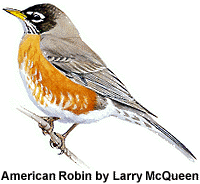American Robin
(Turdus migratorius)
Cool fact: While the female American Robin incubates her second clutch of eggs, the fledged young from the first brood often join adult males at communal nocturnal roosts. Nightly roosting may begin as early as June. Males are joined first by spot-breasted juveniles, then by adult females. The number of robins at a roost peaks in late summer.
Our largest thrush (approximately 10 inches in length), the American Robin is found throughout North America, from extreme northern Canada and as far south as Guatemala. This common and well-known bird is noted for its habit of feeding in lawns where it finds earthworms (by sight, not sound), and for its cheery voice. Robins are often one of the first birds to sing in the morning, singing long choruses of rhythmic paired phrases of two or three syllables that alternately rise and fall in pitch. The dawn singing is reprised at dusk and occasionally throughout the day.
Once breeding season is over, the sweet-singing and familiar robin of our backyards becomes more furtive and shy. Large nomadic flocks form and range over the countryside in search of berries such as mulberry, sumac, grape, viburnum, and cedar, as they shift from their breeding season diet of insects and earthworms to become wholly vegetarian. By September, many are moving south from the northern parts of the eastern half of the country to winter with southern residents in the Middle Atlantic and Gulf states. In the West, Robins wander broadly in search of food and move generally to areas of lower altitude. But some linger as far north as Canada when food supplies are adequate, so the first robin you see in spring may not have come from too far away.
Particularly in the South, where gunners could easily harvest birds from dense wintering flocks, robins were once widely hunted for food. Many were sent to markets where the fat and juicy flesh was held in high regard. In general, however, the robin has benefited from its association with humans. As modern civilization advanced into the plains, the planting of trees and the construction of buildings provided the robin with platforms for their large, not-easily-concealed nests, and their range has since expanded. Similarly, in the arid West, irrigation and suburban lawns have provided the equivalent of moist grassland where robins find food for nestlings.
Description: Adults are gray brown above, with a darker head and tail. The bill is bright yellow; the chin and throat are white, with black vertical striping on the throat. Surrounding the dark eye are white orbital markings. The breast is brick red and the belly is white. In most eastern birds the tail has white corners. Females are somewhat more dull in color; the upperparts are lighter and more brown in color; the head is not so black and thus provides less contrast with the back; and the breast is paler, often edged with white.
The common race of robins found throughout most of the West tends to be more pale and lacks the white outer corners of the tail. Robins of the humid Northern Pacific coastal areas and those from Newfoundland tend to be very dark.
Juveniles are dark on top, much like the adult plumage, but the feathers of the back, upper wings, and rump have streaks of white and blackish tips giving the upperparts a speckled appearance. The cinnamon coloring of the breast is overlaid with conspicuous black spots. There is much individual variation in the cinnamon color of the underparts: some juveniles are largely white underneath. This plumage is molted sometime between August and October, depending on when the individual hatched. Both sexes look alike in juvenal plumage.
